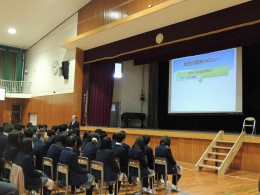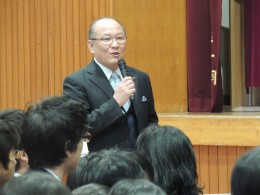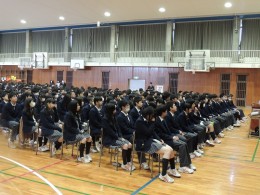President Nakayama Gave a Lecture on Morals at Chiba Prefectural Matsudo Kokusai High School
 On March 18th, President Nakayama gave a lecture on “Morals in the Global Age” in the spacious gymnasium of Chiba Prefectural Matsudo Kokusai High School. In attendance were all those in the first and second years (a total of about 670 students) as well as their teachers.
On March 18th, President Nakayama gave a lecture on “Morals in the Global Age” in the spacious gymnasium of Chiba Prefectural Matsudo Kokusai High School. In attendance were all those in the first and second years (a total of about 670 students) as well as their teachers.
The school began a full year class on morals just last year, and as the end of the school year approached, it needed to draw together the contents of this class (especially in connection with education in the context of global understanding) and to create a moral climate in the school. All the students, except those in the 3rd year, were asked to participate in this task, as was Reitaku University, which agreed to contribute to the review process at the year’s end to strengthen the program.
Lectures on morals usually tend to be rather serious and sober affairs, but discerning students might have detected signs of the considerable thought that the President had put into devising his lecture, as when, for example, he emphasized the importance of acknowledging what is good about Japan in order to establish Japanese identity in our global age. We clearly cannot have empathy towards others without first establishing our own identities, and to illustrate this point the President referred to the stories of “The Three Little Pigs” (which is famous in Japan as a Disney movie) and “The Battle Between the Crab and the Ape” (one of the most famous Japanese fairy tales). He then asked his listeners which story they liked better; as might have been expected, the majority opted for the former. But the President pointed out that the Japanese story had much more to commend it from an ecological point of view. In the Disney story, the most important thing for the little pigs is not the house built out of straw, nor that made from sticks, even though both are biodegradable; praise is given instead to the house made of bricks, despite it being ecologically much more unfriendly. In the story of the battle between an evil monkey and the offspring of a kind crab, on the other hand, the arthropods defeat the monkey (a mammal) with the assistance of a bee (an insect), a chestnut (a plant), some cow dung and a wood mortar (abiosis) who get together and agree to help the baby crabs get revenge on the evil monkey, which is located much higher on the Western scale of beings than they are themselves. So the Japanese story is more nature-centric and extends much further into what is called “deep ecology”.
The large audience listened attentively for an hour to this unusual and amusing approach to the topic, and clearly appreciated the humour as well as the insights of the piece.





